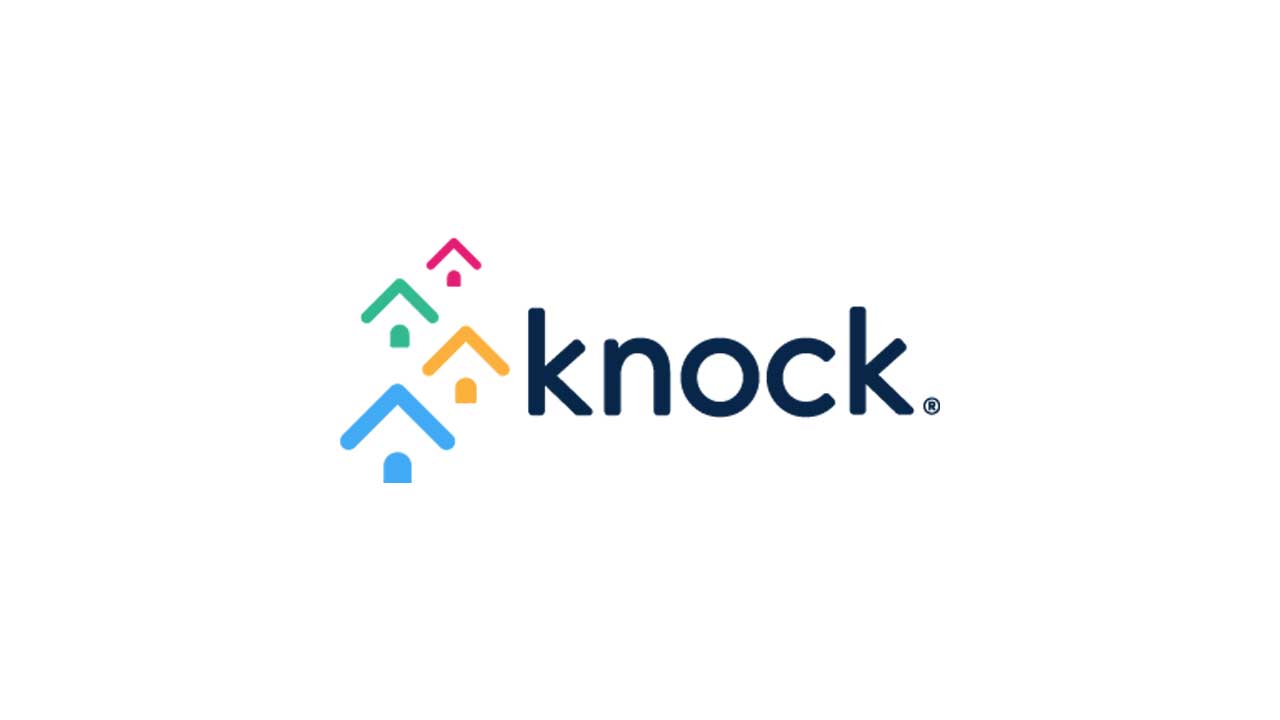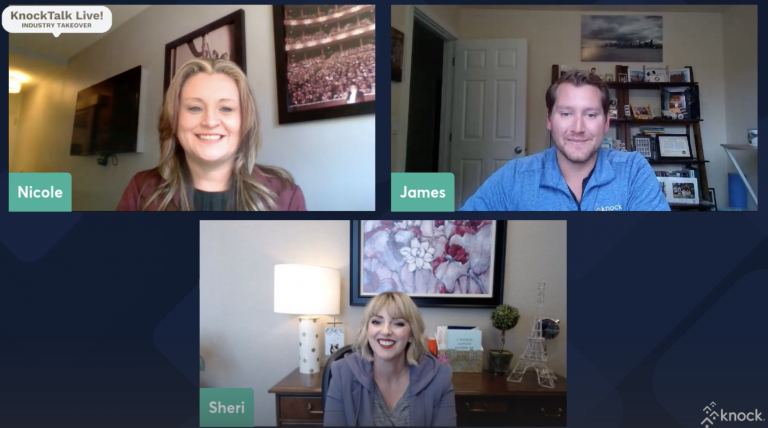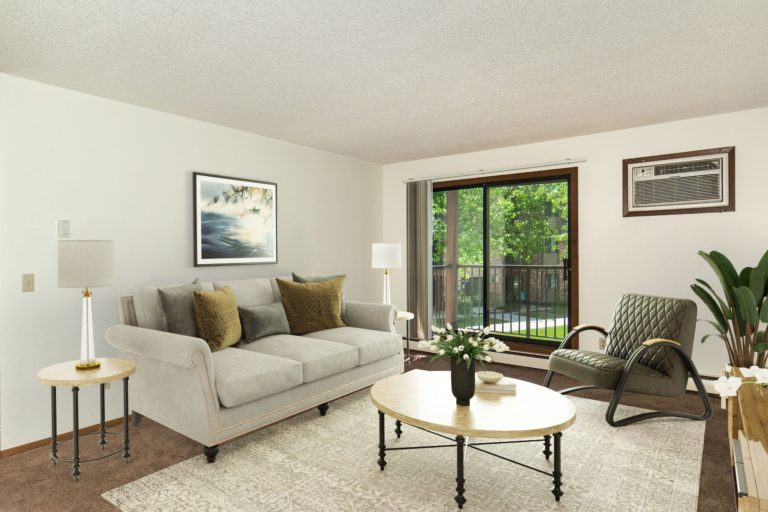Knock Talk: Ep. 11 Multifamily Myth-busting with Zumper

This week, Stuart Bern, vice president of partnerships at Knock, sits down with the Natalie Cariola, chief sales officer at Zumper, to dig deep into the data to learn if these 3 multifamily market trends are fact or fiction.
Watch or read the full transcript below.
Want multifamily insights delivered straight to your inbox? Subscribe to the Knock newsletter!
Transcript
Stuart: Welcome to this special edition of Knock Talk. This has been a long time coming. My name is Stuart Bern. I’m the Vice President of Partnerships at Knock, and I’m here with my good friend, Natalie Cariola, Senior Vice President of Sales at Zumper.
Today what we’re going to do is go through three different anecdotes – we’re continually hearing these anecdotes from our colleagues in the industry and on the news – and we’re going to use data to either prove or disprove each of these different points.
I think this is going to be a lot of fun. But before we jump in, Natalie, do you mind telling us a little bit about your background and about Zumper?
Natalie: Of course. And thank you for having us. We love Knock. You all are such industry leaders and to be able to partner with you on this is fantastic. So thank you for having me. Again, my name is Natalie.
I got my start in the industry when I was 17 years old, leasing apartments. So I’ve been in the multifamily industry, pretty much most of my career. The last four years, I have been at Zumper building and leading our sales organization, as well as our customer success function.
Zumper Is a rental marketplace. Essentially we have millions and millions of renters that are looking to find their next home on Zumper, and we provide the multifamily industry the opportunity to get access to those renters.
Is it a renters’ market?
Stuart: Great. So our first anecdote that we’re going to either prove or disprove is: It’s a renters market. True or false?
I saw on the NMHC Rent Payment Tracker that it showed around 86.2% of households pay their rent for September. And it showed that this has been steadily tracking down since June and that, as you know, Natalie, is our traditional busy leasing season.
So, my question would be, what are you seeing like our concessions in fact rising, would you, in fact, call it a renters market?
Natalie: That’s a good question. So my answer is, ‘not yet.‘ Based off of the data that we’re seeing is that renters want it to be a renters market. But the multifamily industry hasn’t quite decided yet 100% that it is. What I mean by that is what we’re seeing is a little bit of a squeezing when it comes to rent prices.
The top five to seven most expensive cities in the United States are in fact decreasing rents, which also is going to equal concessions going up. But on the flip side, what we’re seeing is all of the smaller, less expensive cities are actually increasing their prices and part of this has to do with the migration.
When you look at the large cities that are decreasing rents, we are seeing pretty substantial 10% to 15% rent decreases in places like New York and San Francisco. But what you have to remember as you’re talking about two of the most expensive markets in the United States. So when you ask if it’s a renters market, average rents going from $4,000 to $3,400 doesn’t necessarily equal a renters market.
The other thing that’s interesting that we’re finding is – we just conducted our annual renters survey. We have an increase of 40% of renters moving in with friends and family. Now, part of that has to do with the economic conditions, but we also believe, part of that is that people are in a sit and wait place. Right now they’re looking. They want to find their next home, but they’re waiting for the deals to get a little bit sweeter.
Are renters really moving to the ‘burbs?
Stuart: Yeah, I mean, you think about a place like New York City. I think right now they’re saying 15,000 vacant units. That makes me sad to hear. It has a special piece of my heart, so thank you for that. That’s a great answer. Let’s move on to the next one.
We read about the mass exodus that’s taking place right now. Maybe it’s renters looking to buy, so is there really a mass exodus move to let’s call it homeownership? Or we hear also about it in terms of folks moving from the cities to the burbs. Zumper’s done a lot of research on this topic. So my question is, what does the data tell us? Is this true, is there really a mass exodus that’s taking place right now?
Natalie: So that is a great question, and and looking at the data, because we have the ability to look at where renter searching where they are coming from – I will tell you the answer is yes, we are seeing an exodus from almost every city in the United States. And what I mean by that is, is that the two cities that need to be concerned about the mass exodus.
As you stated before, in New York City and San Francisco, we’re actually seeing in like San Francisco year over year inventory growth. We’re talking almost double the amount of inventory that’s on the market than it was a year ago. And so when you see that sort of growth, but we’re not seeing that increase in searches or leads. What’s really interesting though, is the dynamic that you’re seeing throughout the rest of the United States.
I, you know, if you remember, we’ve both been in the industry for a long time. There used to be a lot of data to suggest that most people move within a few miles of where they’re already living. Our data is showing that all of that has changed. Everybody is looking to potentially get out of the city that they’re in, and look at opportunities and new cities.
So the reason I say that New York City and San Francisco needs to be concerned and other markets might not is, for example, we’re seeing a number of people in Los Angeles that are now searching and Phoenix, they’re searching in Vegas Reno, Texas. They are looking for opportunities to get out of LA. But on the flip side, people in Texas people in Nevada people in Phoenix, are all searching to come to Los Angeles.
I take another market that is interesting, Chicago. The amount of people in Chicago that are now searching in Indianapolis is amazing. When you look at the amount of people that are looking to get out of Chicago and move to places like Indiana.
But then you look at Kansas City in St. Louis. They’re looking at opportunities to move to Chicago. So what’s really interesting is that San Francisco and New York are an anomaly, but the rest of the United States, we’re just seeing the recycling of renters.
Is new multifamily technology here to stay?
Stuart: Super interesting. I mean, I totally get it, and I can only imagine that the kind of remote work is definitely propelling LA and New York situations and now you’re living in a 500 square foot studio in New York City. Why would you not move to Arizona, Phoenix and go hike during your lunch breaks? But that’s a super interesting flip that you’re seeing some of these other tertiary markets that you mentioned.
Let’s move on to the next one. So I feel this year, more than ever. Our customers have really been embracing this, ‘let’s give it a try attitude’, implementing innovative tools to help them navigate the need for a virtual environment.
Remote work that we were just talking about. And they’re saying that it’s here to stay and from an operator point of view, we’ve really seen a large uptick in virtual tours that are taking place, particularly through our platform – as you’d expect. And I was looking through the dumper survey results from the April that looked at how renters are adapting to the current landscape. And read that the main way that search criteria has been affected post pandemic was that renters are looking for more virtual tours. And many apartment properties and marketplaces have introduced online tour and digital leasing teachers, you know, you can take jumpers instrument for example.
So a few questions for you. Natalie. What are you seeing through Zumper’s data to what has changed? Is this rapid adoption of virtual touring and other online applications here to stay.
Natalie: Yeah, those are good questions. And so we absolutely believe that it is here to stay. So you may know we recently announced a partnership with Matterport where we’re now offering packages that include Matterport. We did that simply because we saw the data. That showed 70% or more of renters are willing to rent an apartment without ever actually touring it because the technology is now so good.
With being able to do 3D virtual touring online leasing agents adapting to technology and doing FaceTime tours. Onsite staff really getting buy-in from them doing their own YouTube videos. It’s been amazing. What we’ve seen, especially our on site teams do. During COVID and so we absolutely believe that that’s here to stay, and we believe that it gives renters a number of opportunities to essentially tour an apartment without physically having to pull into a leasing office parking lot and go look at it. I’m to take that a little bit further. We added Filters in December, so that you could filter by companies that were doing online touring who has a video, who has 3D tours. As a result, properties that have three view tours or videos we’re seeing a 30% increase in leads.
And that’s literally just in the last few months. And so not only has the behavior of our onsite staff changed, the behavior of renters has changed because they’re now looking for properties that are doing that, which is pretty exciting.
Um, you know the other thing is, you mentioned Instagram, which for us is the end then transaction where a renter can not only search for their next home, but they can actually fill out an application.
And reserve an apartment and essentially sign a lease all through one platform that is absolutely us betting on that this is not going away and that renters are going to want to be able to rent their next home on an app on their phone with a click of a button.
Stuart: Yep. Yeah, really impressive. What do you guys have done with Matterport and great stat around 70% are renting virtually. You know 10 years ago I was renting my first apartment in New York City. And you know, I was in Atlanta, and my roommate at the time was showing me the apartment through FaceTime, and so that that is now kind of come full circle. And to your point, definitely here to stay.
Natalie: So you’re quite a pioneer, by the way, 10 years ago I feel a little old school. I took advantage of coven to do a short term lease in a new city and just kind of enjoy it.
And I rented officially my first apartment ever that I didn’t tour in person and did it paraphrase time tour. So you are 10 years ahead of me and I think a lot of renters.
Stuart: Okay, so now let’s focus on the future. So, sure we’re going through some challenges, as we all know, but let’s not harp on that. What in the industry is making you hopeful or excited about the future?
Natalie: Yeah, it’s a great question, and I was thinking about this as far as what I’ve seen recently that makes me excited about the future. And, I think looking at the way our property management companies and onsite teams responded to COVID and to shelter-in-place orders. It really impressed me.
All of our onsite teams really had to adopt technology very quickly. And I think in our industry people talk about it being a little bit old school or a little bit archaic, maybe slow to adopt new technology. And I think specifically are onsite teams proved that that wasn’t the case. We had property managers that were building their own YouTube channels filming YouTube videos. In fact, we had over 1,000 YouTube videos added to suffer from onsite teams, which was amazing. We see leasing agents grabbing their own mobile phones and doing FaceTime tours – anything that they could do to continue keeping operations going and continue leasing apartments. It makes me really hopeful.
When I think about companies like Knock and companies like Zumper, they are trying to innovate, and are really customer centric, and want to change the industry, and change the landscape, and to see that our industry is so willing to adopt new technology. It really made me hopeful for all of us.
Stuart: Great answer. You know, Natalie from, from my perspective, multifamily is just so resilient on so many levels. You know, you think about it on a macroeconomic level multifamily has historically been recession proof. Like, especially when you look at it, versus other commercial asset classes. You look at it on an industry level. It’s such a tight knit group of professionals. Kind of alluding to your point earlier who come together to support one another during difficult times, like we’re going through now. And, you know, lastly, you look at it on a resiliency level. Look at how much the industry is growing over the past year, and even over the past few months.
You know, we’ve all come together. We’ve helped each other, innovate. We’ve partnered and we found ways that we can make one plus one equals three.It’s really an amazing amount of new technology and really unique solutions have come to fruition. And we’ve moved the needle forward with things like self guided tours and virtual tours in AI leasing which I’d argue were just so ripe for disruption. And this industry has attracted an incredible amount of talent in capital and for thinkers and I think this is just the beginning for prop tech and I’m really excited for what’s next.
So with that, thank you. Natalie, the entire Zumper team for being such wonderful partners. Thank you to our viewers and stay tuned for the next edition of Knock Talk.


